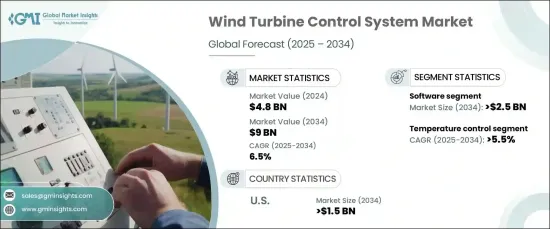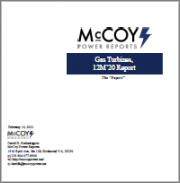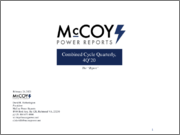
|
시장보고서
상품코드
1665237
세계의 풍력 터빈 제어 시스템 시장 : 기회, 성장 촉진요인, 산업 동향 분석, 예측(2025-2034년)Wind Turbine Control System Market Opportunity, Growth Drivers, Industry Trend Analysis, and Forecast 2025 - 2034 |
||||||
세계 풍력 터빈 제어 시스템 시장은 2024년 48억 달러에 달했고, 2025-2034년까지 CAGR 6.5%로 성장할 것으로 예측됩니다.
기존의 에너지원 고갈에 대한 환경문제 증가와 재생가능 에너지에 대한 투자 증가가 시장의 큰 성장을 가속하고 있습니다. 또한 풍력 터빈의 효율성과 신뢰성 향상을 목표로 하는 연구개발의 진전이 시장 확대를 지원하는 매우 중요한 역할을 하고 있습니다. 또한 해상 풍력발전소의 설치가 증가하고 있는 것도 유리한 기회를 만들어 시장의 성장을 더욱 뒷받침하고 있습니다.

풍력 터빈 제어 시스템 시장의 소프트웨어 부문은 2034년까지 25억 달러의 매출이 예상됩니다. 이러한 급성장의 배경은 에너지 제어 시스템의 채택 확대와 성능을 최적화하기 위한 데이터 주도 통찰력에 대한 수요 증가가 있습니다. 이러한 첨단 소프트웨어 솔루션은 비용 효율성 향상, 그리드 통합의 간소화, 더 많은 정보를 통한 의사결정 실현에 필수적입니다. 신흥국이 디지털 전환과 에너지 인프라의 현대화에 주력하는 가운데, 정교한 소프트웨어 컴포넌트의 채용이 급속히 가속화되고 있습니다.
| 시장 범위 | |
|---|---|
| 시작 연도 | 2024년 |
| 예측 연도 | 2025-2034년 |
| 시작 금액 | 48억 달러 |
| 예측 금액 | 90억 달러 |
| CAGR | 6.5% |
온도 제어 부문은 2034년까지 연평균 복합 성장률(CAGR) 5.5%의 견조한 성장이 예상됩니다. 실시간 데이터와 예측 알고리즘을 활용한 첨단 온도 제어 시스템은 풍력 터빈의 성능과 신뢰성을 향상시키는 데 필수적입니다. 온도 센서, 통신 네트워크, 예측 기술의 혁신이 계속해서 운전 효율을 높이는 한편, 그리드 통합을 위한 엄격한 컴플라이언스 기준이 고정밀 온도 제어 시스템의 채용을 뒷받침하고 시장 확대를 더욱 뒷받침하고 있습니다.
미국의 풍력 터빈 제어 시스템 시장은 2034년까지 15억 달러를 창출할 것으로 예상됩니다. 청정에너지와 환경의 지속가능성을 증진시키는 정부의 호의적인 시책이 이 지역 성장의 주요 추진력이 되고 있습니다. 운송과 제조업을 중심으로 산업의 전기가 진행되고 있는 것이 풍력에너지 솔루션 수요를 밀어 올리고 있습니다. 또한, 전력 장비 및 부품의 현지 생산화 동향은 맞춤형 풍력 터빈 제어 시스템의 요구를 촉진하고 지역 시장의 개척을 촉진합니다.
목차
제1장 조사 방법과 조사 범위
- 시장 범위와 정의
- 시장 추정·예측 파라미터
- 예측 계산
- 데이터 소스
- 1차 데이터
- 2차 데이터
- 유료
- 공적
제2장 주요 요약
제3장 산업 인사이트
- 생태계 분석
- 규제 상황
- 산업에 미치는 영향요인
- 성장 촉진요인
- 산업의 잠재적 리스크 및 과제
- 성장 가능성 분석
- Porter's Five Forces 분석
- 공급기업의 협상력
- 구매자의 협상력
- 신규 참가업체의 위협
- 대체품의 위협
- PESTEL 분석
제4장 경쟁 구도
- 소개
- 전략적 전망
- 혁신과 지속가능성의 전망
제5장 시장 규모와 예측 : 컴포넌트별, 2021-2034년
- 주요 동향
- 소프트웨어
- 컨트롤러
- 센서
- HMI
- 기타
제6장 시장 규모와 예측 : 기능별, 2021-2034년
- 주요 동향
- 속도 제어
- 온도 제어
- 부하 제어
- 압력 제어
- 기타
제7장 시장 규모와 예측 : 지역별, 2021-2034년
- 주요 동향
- 북미
- 미국
- 캐나다
- 멕시코
- 유럽
- 영국
- 프랑스
- 독일
- 이탈리아
- 러시아
- 스페인
- 아시아태평양
- 중국
- 호주
- 인도
- 일본
- 한국
- 중동 및 아프리카
- 사우디아라비아
- 아랍에미리트(UAE)
- 터키
- 남아프리카
- 이집트
- 라틴아메리카
- 브라질
- 아르헨티나
제8장 기업 프로파일
- ABM Greiffenberger
- AEG Power Solutions
- ANDRITZ
- Danfoss
- Eaton
- Emerson Electric
- General Electric
- Honeywell International
- Ingeteam
- KEBA
- Mitsubishi Electric Corporation
- Nabtesco Corporation
- Rockwell Automation
- Schneider Electric
- Siemens Energy
- Sulzer
- Vestas
- Yokogawa Electric Corporation
The Global Wind Turbine Control System Market is projected to reach USD 4.8 billion in 2024 and grow at a CAGR of 6.5% from 2025 to 2034. Increasing environmental concerns over the depletion of traditional energy sources, coupled with growing investments in renewable energy, are driving significant growth in the market. Additionally, advancements in research and development aimed at enhancing the efficiency and reliability of wind turbines are playing a pivotal role in supporting market expansion. The rising installation of offshore wind farms is also set to create lucrative opportunities, further fueling market growth.

The software segment within the wind turbine control systems market is expected to generate USD 2.5 billion by 2034. This surge is driven by the growing adoption of energy management systems and the increasing demand for data-driven insights to optimize performance. These advanced software solutions are crucial for improving cost efficiency, streamlining grid integration, and enabling more informed decision-making. As emerging economies focus on digital transformation and modernizing their energy infrastructure, the adoption of sophisticated software components is accelerating at a rapid pace.
| Market Scope | |
|---|---|
| Start Year | 2024 |
| Forecast Year | 2025-2034 |
| Start Value | $4.8 Billion |
| Forecast Value | $9 Billion |
| CAGR | 6.5% |
The temperature control segment is anticipated to experience a robust growth rate of 5.5% CAGR through 2034. Advanced temperature management systems, which utilize real-time data and predictive algorithms, are becoming essential for improving wind turbine performance and reliability. Innovations in temperature sensors, communication networks, and forecasting technologies continue to enhance operational efficiency, while strict compliance standards for grid integration push the adoption of high-precision temperature control systems, further supporting market expansion.
The U.S. wind turbine control system market is expected to generate USD 1.5 billion by 2034. Favorable government policies promoting clean energy and environmental sustainability are key drivers of growth in the region. The increasing electrification of industries, particularly in transportation and manufacturing, is boosting the demand for wind energy solutions. Furthermore, the rising trend of localized production of power equipment and components is driving the need for customized wind turbine control systems, fostering regional market development.
Table of Contents
Chapter 1 Methodology & Scope
- 1.1 Market scope & definitions
- 1.2 Market estimates & forecast parameters
- 1.3 Forecast calculation
- 1.4 Data sources
- 1.4.1 Primary
- 1.4.2 Secondary
- 1.4.2.1 Paid
- 1.4.2.2 Public
Chapter 2 Executive Summary
- 2.1 Industry synopsis, 2021 - 2034
Chapter 3 Industry Insights
- 3.1 Industry ecosystem analysis
- 3.2 Regulatory landscape
- 3.3 Industry impact forces
- 3.3.1 Growth drivers
- 3.3.2 Industry pitfalls & challenges
- 3.4 Growth potential analysis
- 3.5 Porter's analysis
- 3.5.1 Bargaining power of suppliers
- 3.5.2 Bargaining power of buyers
- 3.5.3 Threat of new entrants
- 3.5.4 Threat of substitutes
- 3.6 PESTEL analysis
Chapter 4 Competitive Landscape, 2024
- 4.1 Introduction
- 4.2 Strategic outlook
- 4.3 Innovation & sustainability landscape
Chapter 5 Market Size and Forecast, By Component, 2021 – 2034 (USD Million)
- 5.1 Key trends
- 5.2 Software
- 5.3 Controller
- 5.4 Sensors
- 5.5 HMI
- 5.6 Others
Chapter 6 Market Size and Forecast, By Function, 2021 – 2034 (USD Million)
- 6.1 Key trends
- 6.2 Speed control
- 6.3 Temperature control
- 6.4 Load control
- 6.5 Pressure control
- 6.6 Others
Chapter 7 Market Size and Forecast, By Region, 2021 – 2034 (USD Million)
- 7.1 Key trends
- 7.2 North America
- 7.2.1 U.S.
- 7.2.2 Canada
- 7.2.3 Mexico
- 7.3 Europe
- 7.3.1 UK
- 7.3.2 France
- 7.3.3 Germany
- 7.3.4 Italy
- 7.3.5 Russia
- 7.3.6 Spain
- 7.4 Asia Pacific
- 7.4.1 China
- 7.4.2 Australia
- 7.4.3 India
- 7.4.4 Japan
- 7.4.5 South Korea
- 7.5 Middle East & Africa
- 7.5.1 Saudi Arabia
- 7.5.2 UAE
- 7.5.3 Turkey
- 7.5.4 South Africa
- 7.5.5 Egypt
- 7.6 Latin America
- 7.6.1 Brazil
- 7.6.2 Argentina
Chapter 8 Company Profiles
- 8.1 ABM Greiffenberger
- 8.2 AEG Power Solutions
- 8.3 ANDRITZ
- 8.4 Danfoss
- 8.5 Eaton
- 8.6 Emerson Electric
- 8.7 General Electric
- 8.8 Honeywell International
- 8.9 Ingeteam
- 8.10 KEBA
- 8.11 Mitsubishi Electric Corporation
- 8.12 Nabtesco Corporation
- 8.13 Rockwell Automation
- 8.14 Schneider Electric
- 8.15 Siemens Energy
- 8.16 Sulzer
- 8.17 Vestas
- 8.18 Yokogawa Electric Corporation




















